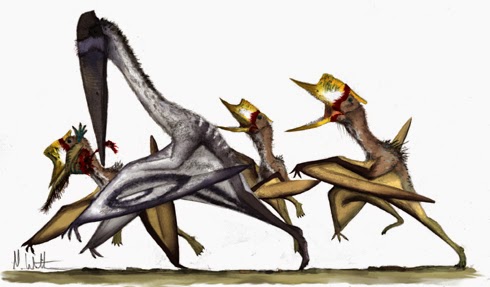 |
| Figure 1: Anurognathus, a small insectivorous pterosaur from the late Jurassic. Artist: Maija Karala. |
While pterosaurs had started out with long tails used to help with stability, more short-tailed pterosaurs showed up in the Jurassic and by the Cretaceous only short-tailed forms remained. Many Cretaceous pterosaurs became both larger and stranger than ever before. One of the strangest pterosaurs to have ever lived would have to have been the ctenochasmid Pterodaustro, from the early Cretaceous of Argentina. While ctenochasmids had been filter-feeding since the late Jurassic, Pterodaustro took it to an extreme degree. Each side of its lower jaw had almost 500 elastic, baleen-like "teeth" used to sift out small aquatic organisms, much like what flamingos do today (Wellnhofer, 1991).
 |
| Figure 2: The bizarre filter-feeding pterosaur Pterodaustro. Artist: Julio Lacerda. |
Many pterosaurs filled predatory niches, such as the stork-like azdarchids and the vulture-like istiodactylids (Witton, 2012). In contrast, there were also pterosaurs that preferred a more plant-based diet, such as the tapejarines, who fed on fruits and nuts (Vullo et al, 2012).
 |
| Figure 3: A pair of Tupandactylus, a type of tapejarine from the early Cretaceous. Artist: Mark Witton. |
While no pterosaur ever became flightless, some like the dsunganipterids and the azhdarchids, developed more ground dwelling lifestyles. The azdarchids had lifestyles akin to giant storks and could grow to a massive sizes, with the largest having wingspans of 10-11 metres and body masses of 200-250 kilograms, making them the largest flying animals to have ever lived. Pterosaurs could reach greater sizes than flying birds, due to their wings being stronger and providing more lift than bird wings and due to their quadrupedal launch giving more launch power than the bipedal launch of birds (Witton & Habib, 2010).
 |
| Figure 4: An azhdarchid tries to keep its prey- a dromaeosaur- away from some thieving dsunganipterids. Artist: Mark Witton. |
This post merely scratches the surface of pterosaur diversity but hopefully gives a good taste of it. Next up we shall see the evolution of a new group of flyers- birds and other flying dinosaurs.
Vullo, R., Marugan-Lobon, J., Kellner, A. W. A., Buscalioni, A. D., Gomez, B., Fuente, M. d. l. & Moratalla, J. J. (2012). A New Crested Pterosaur from the Early Cretaceous of Spain: The First European Tapejarid (Pterodactyloidea: Azhdarchoidea): e38900. PloS One, 7 (7).
Wellnhofer, P. (1991). The Illustrated Encyclopedia of Pterosaurs. Crescent Books: New York.
Witton, M. P. & Habib, M. B. (2010). On the Size and Flight Diversity of Giant Pterosaurs, the Use of Birds as Pterosaur Analogues and Comments on Pterosaur Flightlessness. PloS One, 5 (11).
Witton, M. P. (2012). New Insights into the Skull of Istiodactylus latidens (Ornithocheiroidea, Pterodactyloidea): e33170. PloS One, 7 (3).
Image sources
Figure 1: Accessed March 31, 2015, from http://41.media.tumblr.com/e5584185d859a6e0d7b91f6e78d4698e/tumblr_mvcyy72ht01rbztl0o1_1280.jpg
Figure 2: Accessed March 31, 2015, from http://fc03.deviantart.net/fs71/f/2012/131/2/1/feeding_off_a_mirror_by_karkajou1993-d4vg3i3.png
Figure 3: Accessed March 31, 2015, from http://invivomagazin.sk/admin/obrazky/382051192tupan%20witton.jpg
Figure 4: Accessed March 31, 2015, from http://scienceblogs.com/tetrapodzoology/wp-content/blogs.dir/471/files/2012/05/i-18b8cd89e1c14b6727ca53eca47ca33c-Witton-dsungaripterids-hound-azhdarchid-Sept-2010.jpg






